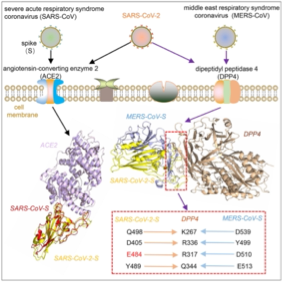MERS-CoV Receptor DPP4 as a Candidate Binding Target of the SARS-CoV-2 Spike
Author: Beomyheok Lee

Highlights:
- SARS-CoV-2 spike receptor-binding domain has a potentially high affinity to DPP4.
- SARS-CoV-2-S/DPP4 binding shares key DPP4 residues with that of MERS-CoV-S/DPP4.
- E484 and adjacent mutations are critical for the DPP4-binding ability of SARS-CoV-2-S.
The attachment of the virus on the host cell surface receptor is the key step of viral entry and infection. Therefore, protein-protein interactions between human cells and viruses have been actively studied, including this novel SARS-CoV-2.
A new study from iScience published on June 26th, 2020 suggests that dipeptidyl peptidase 4 (DPP4) may be another binding target of the SARS-CoV-2 virus other than angiotensin-converting enzyme 2 (ACE2) proteins, a well-known binding target of SARS-CoV-2 and SARS-CoV. Bioinformatics was used to predict 3D structures of viral spike (S) proteins of SARS-CoV-2 and estimate its binding affinity with human proteins that are originally predicted to be interacting with SARS-CoV-2 glycoprotein. Analyses results showed that there was a high binding affinity between human DPP4 enzyme and the receptor-binding domain of SARS-CoV-2 glycoprotein. In addition, the main binding residue of human DPP4 enzyme was identical to those known for binding to MERS-CoV spike proteins. E484 insertion and substitution mutation in SARS-CoV-2-S was identified as the main reason which has increased DPP4-binding ability of SARS-CoV-2 compared to SARS-CoV. In-depth follow-up studies on this research topic may provide new insight in understanding the pathogenesis of SARS-CoV-2 and help surveillance and therapeutic strategies of COVID19.
References:
Li, Y., Zhang, Z., Yang, L., Lian, X., Xie, Y., Li, S., … & Lu, J. (2020). The MERS-CoV receptor DPP4 as a candidate binding target of the SARS-CoV-2 spike. Iscience, 23(6), 101160.